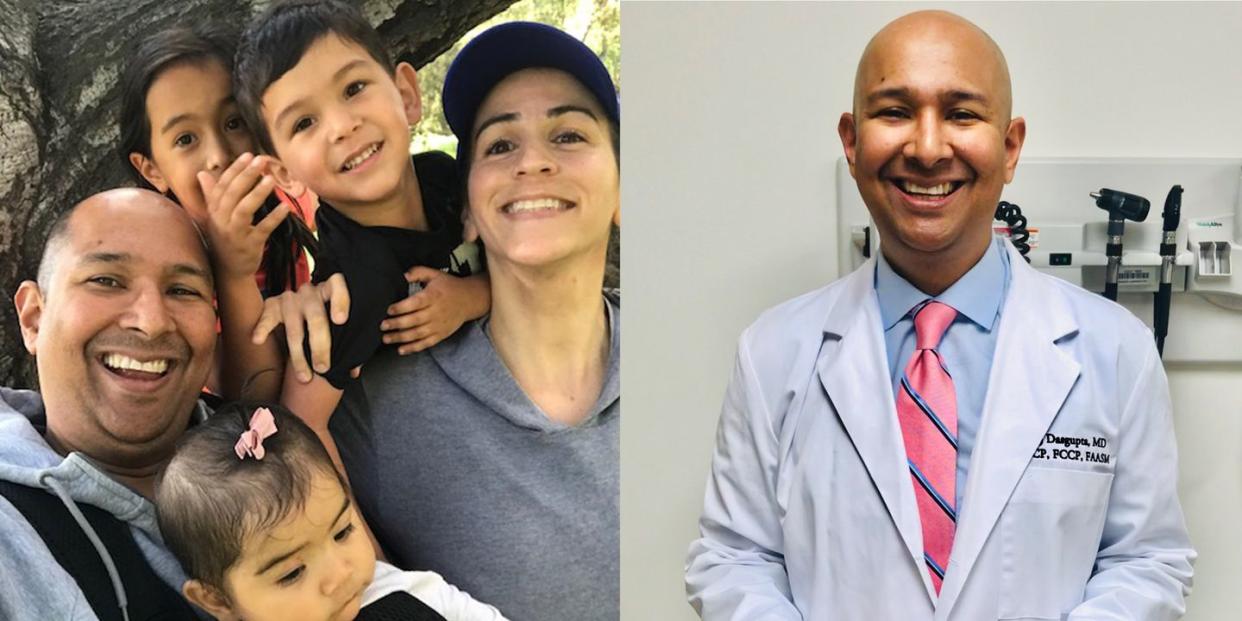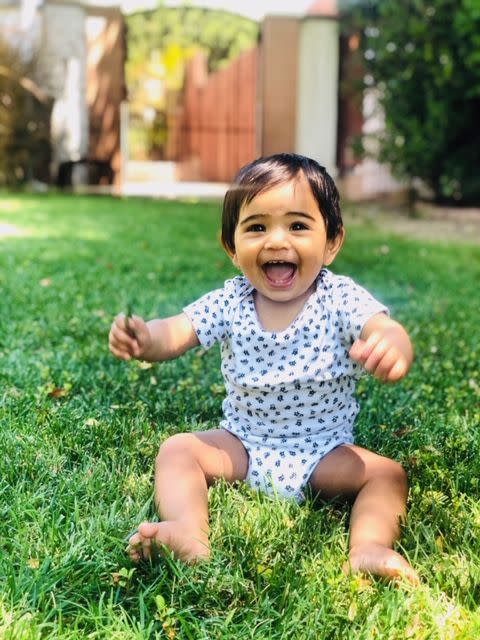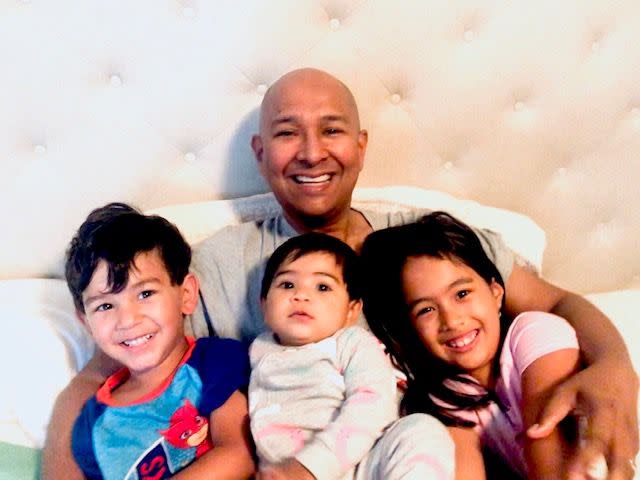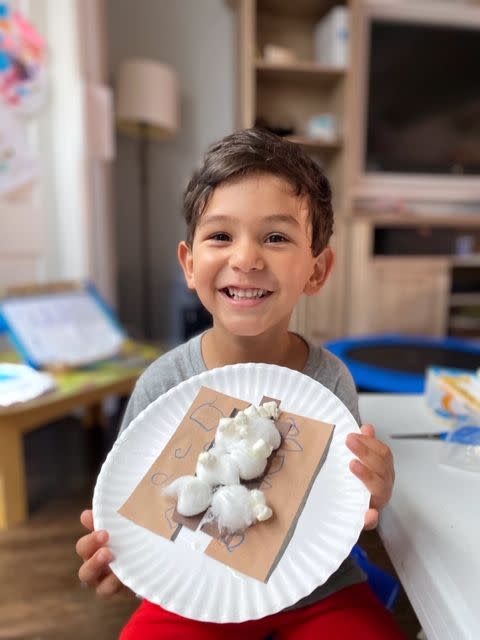2 Doctors, 3 Kids Under 8. Here's What Happened When the Whole Family Got COVID-19.

It started, as many things do, with a mother’s instinct. Michelle Dasgupta’s youngest, Sadie, was a little warmer than usual—and a little fussier, too. A 9-month-old can’t say why, but Michelle knew something was wrong.
She had three baby thermometers scattered around the house—one for the underarm, one for the bum, and one for the mouth. All three were used, all three gave different readings. None of them said “fever,” i.e. a temperature of 100.3°F or above. Still, Sadie wasn’t Sadie.
Two days later, just as the baby’s symptoms—fatigue, fussiness, and a runny nose—were self-resolving, Michelle’s older kids, Mina, 7, and Aiden, 5, were acting weird. Like their baby sister, they felt warm to the touch. Plus, their dad Rajkumar (Raj) says, they weren’t “bouncing off the walls” like usual.

By Monday, July 20, Michelle felt it too. Her symptoms were “milder than a sinus infection” and easily dismissible. But, just to be safe, she decided she and Mina would go to a nearby urgent care center to get tested for COVID-19.
Raj and Michelle are both doctors. Raj is a pulmonary and critical care specialist at USC, and Michelle is a rheumatologist. Despite their high-risk professions, Michelle's coronavirus results still took four days to come back. "If a test is going to be helpful for someone, you'll need to get those results back within 24 hours," Raj says.
Michelle and Mina both tested positive for the novel coronavirus. Not only that, Michelle learned as she was pushing a stroller uphill, on a run with Aiden, but she was to assume her entire household had it: her husband, her two elementary-school-age children, her newborn, and even her two dogs, Ringo and Clifford.
Both doctors were shocked. While Raj is also medical contributor for KABC local news in Southern California and is constantly giving advice on contagious viruses like the novel coronavirus, he says hearing he was COVID-19 positive was “like something out of the Twilight Zone. You’re not a physician anymore. You’re a patient.” The first thing he did was call a friend, an infectious disease doctor. “I thought, I know I know the answers to these questions, but I just want someone to tell them to me.” His friend told Raj not to panic. “Now I really understand why we say this on TV and why I tell this to patients, because the first thing you do is backtrack and think, Who did I talk to? What did I do? What happens to my son if he has shortness of breath?”
After Raj and Michelle processed their diagnoses, they each called their office to inform their teams. (Raj says it's possible that he or Michelle contracted the virus at work, but since Sadie was the first to show symptoms, they suspect she may have picked it up on one of their family walks around the neighborhood.) Next came telling their parents and oldest daughter, Mina, which was more emotional. Up until then, Raj and Michelle had been quizzing Mina every day on the three musts of preventing the spread of COVID-19. Mina would answer: staying at least six feet apart from others, wearing a mask, and washing your hands. She understood that the novel coronavirus was “something that the whole country was going through,” says Raj, “but I never explained to her what COVID-19 does to the body, or what it means to be in the hospital or the ICU.” He says he still thinks back and wonders if he should have done anything differently in explaining that his daughter had COVID-19, because Mina took the news to heart.

“Am I going to die?” she asked her dad through tears. “We said no,” he says today. “I would say with 99.9% confidence right now that we’re going to be OK, but when we found out, that number was a little lower. Still, you say what they need to hear, which is that you’re going to be just fine. Mommy and Daddy are always going to be there for you, and we’re not going to let anything happen to you.”
Raj chokes up as he recalls this. “My wife and I both realized, when we said that, that we don’t have control of the coronavirus.” He says Mina has also suffered socially by the pandemic. “She loves to talk to people, and there are things that you really can’t accomplish on FaceTime or Zoom,” he says. “I really feel that she misses being with her friends.”
After the emotional conversations with his daughter, Raj says the second hardest part of having COVID-19 are the games his mind played. “Every morning you wake up after you’re positive, you just pray you don’t have a sore throat,” he says. “Every little cough you have, every little sneeze you have...you’re worried you’re on the brink of getting worse.”
Raj now says Americans are one or the other: People who got COVID and people who will. “No one is safe at this point, and unfortunately we have to stay vigilant because the COVID club is growing,” he says. No matter your status today, something all parents can relate to is the difficulty in explaining social distancing to kids—especially if they have special needs. Protecting Aiden, 5, who has autism, has been difficult, Raj says. Before he and his family got sick, he invited his parents, who live 20 minutes away, to come by for a socially distanced visit with their grandkids. Both in their 70s, the elder Dasguptas pulled into Raj and Michelle's driveway and rolled down the windows, chatting through their masks.
“Our Aiden ran straight toward the car and I had to run and football tackle him,” says Raj. “It’s just really scary. My dad has heart disease and diabetes. He is the poster child of Don’t Get COVID, you know what I mean?”

Today, all of the Dasguptas are healthy. Luckily, no one's symptoms went beyond a sore throat, slight fever, and fatigue, the last of which cleared up for Raj and Michelle on August 8, preceding a 10-day quarantine for added caution. Mina and Aiden are back to bouncing off the walls, “happy and playing as if nothing has happened,” says Michelle. During our interview, I can hear baby Sadie’s happy shrieks and squeals through the phone. Ringo and Clifford run carefree throughout the house, unaware that they’re surviving the worst pandemic in a generation.
“Even if the symptoms are really mild, you should go get tested,” says Michelle. “It would be really helpful if everybody had the type of testing where it comes back in two hours.” While we wait on that, the Dasguptas say they’re grateful that their experience with the coronavirus was mild, “because for a lot of people, it’s completely opposite,” says Michelle. “I can’t imagine if any of our kids got sick to the point of going to the hospital. It’s unimaginable.”
Support from readers like you helps us do our best work. Go here to subscribe to Prevention and get 12 FREE gifts. And sign up for our FREE newsletter here for daily health, nutrition, and fitness advice.
You Might Also Like

